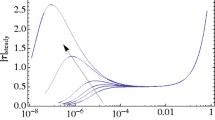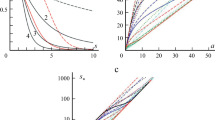Abstract
Homogeneous uniaxial extensional flow of a viscoelastic fluid, namely, the partially extending strand convection model combined with a Newtonian solvent, is investigated for large relaxation time. Initial value problems are addressed, for prescribed constant tensile stress. The limit of large relaxation time introduces a slow time scale of evolution, in addition to a fast time scale for flow. Numerical solutions of the original equations show distinct stages of evolution, which are mathematically analyzed with asymptotic analyses for multiple time scales. We discuss the stages of evolution from equilibrium, as well as unloading the applied stress from a yielded solution. The overall picture which emerges captures a number of features which are usually associated with thixotropic yield stress fluids, such as delayed yielding, and hysteresis for up and down stress ramping. Even at large applied tensile stress, there is persistence of an interval of parameters where the deformation rate increases quickly, only after a delayed response.









Similar content being viewed by others
References
Andrade RJ, Maia JM (2011) A study on the flow, failure and rupture mechanisms of low-density polyethylene in controlled-stress uniaxial extensional flow. J Rheol 55(5):925–937
Ayadi A (2011) Exact analytic solutions of the lubrication equations for squeeze-flow of a biviscous fluid between two parallel disks. J Non-Newtonian Fluid Mech 166:1253–1261
Barnes HA (1999) The yield stress—a review or ‘\(\Pi \alpha \nu \tau \alpha ~\rho \varepsilon \iota \)’—everything flows? J Non-Newtonian Fluid Mech 81:133–178
Barnes HA, Walters K (1985) The yield stress myth? Rheol Acta 24:323–326
Caton F, Baravian C (2008) Plastic behavior of some yield stress fluids: from creep to long-time yield. Rheol Acta 47:601–607
Coussot P (2005) Rheometry of pastes, suspensions, and granular materials: applications in industry and environment. Wiley, Hoboken
Coussot P, Nguyen QD, Huynh HT, Bonn D (2002) Viscosity bifurcation in thixotropic, yielding fluids. J Rheol 46:573–589
Cromer M, Cook L, McKinley G (2009) Extensional flow of wormlike micellar solutions. Chem Eng Sci 64:4588–4596
Denn MM, Bonn D (2011) Issues in the flow of yield-stress liquids. Rheol Acta 50(4):307–315
Dimitriou CJ, Ewoldt RH, McKinley GH (2013) Describing and prescribing the constitutive response of yield stress fluids using large amplitude oscillatory shear stress. J Rheol 57:27–70
Larson RG (1984) A constitutive equation for polymer melts based on partially extending strand convection. J Rheol 28:545–571
Maki K, Renardy Y (2010) The dynamics of a simple model for a thixotropic yield stress fluid. J Non-Newtonian Fluid Mech 165:1373–1385
Maki KL, Renardy Y (2012) The dynamics of a viscoelastic fluid which displays thixotropic yield stress behavior. J Non-Newtonian Fluid Mech 181–182:30–50
Maxey J (2007) Thixotropy and yield stress behavior in drilling fluids, AADE-07-NTCE-37. In: Proceedings of the 2007 American association of drilling engineers national technical conference and exhibition, p 10
Maxey J, Ewoldt R, Winter P, McKinley G (2008) Yield stress: what is the true value? In: Proceedings of the 2008 AADE-08-DF-HO-27. American Association of Drilling Engineers, pp 1–10
Meeten GH (2002) Constant-force squeeze flow of soft solids. Rheol Acta 41:557–566
Mewis J, Wagner NJ (2009) Thixotropy. Adv Colloid Interf Sci 147–148:214–227
Mewis J, Wagner NJ (2012) Colloidal suspension rheology. Cambridge University Press, Cambridge
Møller PCF, Mewis J, Bonn D (2006) Yield stress and thixotropy: on the difficulty of measuring yield stresses in practice. Soft Matter 2:274–283
Møller PCF, Fall A, Chikkadi V, Derks D, Bonn D (2009) An attempt to categorize yield stress fluid behavior. Phil Trans R Soc A 367(1909):5139–5155
Mujumdar A, Beris AN, Metzner AB (2002) Transient phenomena in thixotropic systems. J Non-Newtonian Fluid Mech 102:157–178
Ovarlez G, Barral Q, Coussot P (2010) Three-dimensional jamming and flows of soft glassy materials. Nat Mater 9:115–119
Papanastasiou T (1987) Flows of materials with yield. J Rheol 31:385–404
Ragouilliaux A, Ovarlez G, Shahidzadeh-Bonn N, Herzhaft B, Palermo T, Coussot P (2007) Transition from a simple yield-stress fluid to a thixotropic materials. Phys Rev E 76(051):408
Renardy M (2010) The mathematics of myth: yield stress behavior as a limit of non-monotone constitutive theories. J Non-Newtonian Fluid Mech 165:519–526
Roussel N, Ovarlez G, Garrault S, Brumaud C (2012) The origins of thixotropy of fresh cement pastes. Cem Concr Res 42(1):148–157
Shaukat A, Sharma A, Joshi YM (2012) Squeeze flow behavior of (soft glassy) thixotropic material. J Non-Newtonian Fluid Mech 167–168:9–17
Sherwood JD, Durban D (1998) Squeeze flow of a Herschel–Bulkley fluid. J Non-Newtonian Fluid Mech 77:115–121
Stokes JR, Telford JH (2004) Measuring the yield behaviour of structured fluids. J Non-Newtonian Fluid Mech 124:137–146
Wilson HJ, Fielding SM (2006) Linear instability of planar shear banded flow of both diffusive and non-diffusive Johnson–Segalman fluids. J Non-Newtonian Fluid Mech 138(2–3):181–196
Acknowledgments
This research is supported by NSF-DMS-1311707.
Author information
Authors and Affiliations
Corresponding author
Appendix
Appendix
Intersection of the initial fast curve with the slow curve
This section provides the calculation that leads to the statement at the end of the section titled “Fast dynamics,” for the initial fast curve to intersect the slow manifold. When the intersection occurs, the solution stays unyielded, and otherwise it yields. The initial fast curve intersects a slow curve when \(\kappa =0\) or \(\tau =\psi (s(t))(C_{11}(t)-C_{22}(t))\), where \(C_{11}=C_{22}^{-2}\). This requires \(\tau =\frac {1-C_{22}^{3}}{1+2C_{22}^3+\alpha C_{22}^{2} }\), which simplifies to
Thus, given \(\tau >0\) and \(\alpha >-3\), we want to know if Eq. 35 is satisfied before \(C_{22}\) hits 0.
We observe several properties about the curve \(r(C_{22})\) vs. \(C_{22}\): 1. \(r(0)=\tau -1=\begin {cases} >0 &\text {if} \tau >1 \\ <0 & \text {if} \tau <1. \end {cases}\) 2. \(r(1)=(3+\alpha )\tau >0\). 3. \(r(-\infty )<0\).
Case \(\tau <1\) has a root for \(0<C_{22}<1\)
Suppose \(\tau <1\). Since \(r(1)>0\) and \(r(0)<0\), there is at least one real root for \(0<C_{22}<1\). There is at least one real root in this interval. Since \(r(-\infty )<0\) and \(r(0)<0\), there are either no negative roots, or two negative roots; however, we are not concerned with negative roots. Figure 10a summarizes the behavior of \(r(C_{22})\) for \(\tau <1\) and \(\alpha <0\). Figure 10b shows the two possible cases for \(\alpha >0\).
Schematic of \(r(C_{22})\) vs. \(C_{22}\), defined in Eq. 35. a \(\tau <1\), \(\alpha <0\). b \(\tau <1\), \(\alpha >0\). Two possibilities. In both, there is a transition from the fast curve to a slow curve at the nearest zero of \(r(C_{22})\)
Case \(\tau >1\) has no roots for \(\alpha >0\)
If \(\tau >1\), then \(r(\infty )<0\) and \(r(0)>0\) so there is at least one negative root. Since \(r(1)>0\), there are either two real roots for \(0<C_{22}<1\) or none. To proceed, we use further properties of \(r(C_{22})\): 4. The extrema are at \(r'=0\): \(C_{22}=0,C_{22e}\), where
Since \(\alpha >-3\), we have \(\frac {-\alpha }{3}<1\), and together with \(\frac {2\tau }{1+2\tau }<1\), we see that \(C_{22e}<1\). If \(\alpha >0\), then \(C_{22e}<0\) so that the local extrema are at 0 and a negative value. In this case, the curve has a positive slope from \(C_{22}=1\) down to 0 where \(r(0)>0\), so that there are no zeros in the interval \(0<C_{22}<1\). This is shown in the schematic of Fig. 11a. 5. Since \(r''(0)=2\tau \alpha \), \(C_{22}=0\) is a local minimum if \(\alpha >0\) (see Fig. 11a). If, on the other hand, \(\alpha <0\), then \(C_{22}=0\) is a local maximum. 6. Since \(r''( C_{22e})=-2\tau \alpha \), this is a local maximum if \(\alpha >0\) (Fig. 11a) and a local minimum if \(-3<\alpha <0\). In addition, we see that \(r( C_{22e})= \tau -1 + \frac {4 \alpha ^{3} \tau ^{3}}{27 (1 + 2 \tau )^{2}}\). Thus, if \(\tau >1\) and \(\alpha >0\), then \(r (C_{22e})>0\), and this means that there are no roots of the cubic equation between 0 and 1; therefore, the flow yields. This is the case of Fig. 11a.
Schematic of \(r(C_{22})\) vs. \(C_{22}\), defined in Eq. 35. a \(\tau >1\), \(\alpha >0\). The fast curve does not meet the slow curve, but proceeds to yielding. b \(\tau >1\), \(\alpha <0\). Two possibilities. There is a root if \(r(C_{22e})<0\) (solid line), where \(C_{22e}\) is the local extremum, so the solution lands on a slow manifold. There is no root (dashed line) if \(r(C_{22e})>0\) so the solution yields
The curve \(r(C_{22e})=0\) in the \(\tau \) vs. \(\alpha \) plane, where \(C_{22e}\) is the local extremum of \(r(C_{22})=0\). To the left of the curve, the fast curve intersects the slow curve. To the right of the curve, the fast curve does not intersect the slow curve. The vertical dashed line represents \(\tau =1\)
However, if \(\alpha <0\), then the last term in \(r(C_{22e})\) is \({\frac {- \alpha }{3}^{3}} \frac {-2\tau }{(1 + 2 \tau )^{2}} > 0\). Therefore, for the case \(\tau >1\), the value of r at the local minimum could be positive or negative. If \(r(C_{22e})<0\), then there is a root of \(r(C_{22})=0\) for \(0<C_{22}<1\) and the fast curve meets a slow curve. Figure 12 shows the case \(\alpha <0\) and \(\tau >1\). The \(\alpha \) vs. \(\tau \) plane is cut by the curve \(r(C_{22e})=0\). The region where \(r(C_{22e})<0\) is to the left of the curve, and this is the region where the initial fast curve meets a slow curve. The initial fast dynamics chooses the root of \(r(C_{22})=0\) closest to 1. There are two possibilities in Fig. 10b: the dashed line corresponds to the right of the curve in Fig. 12 and the solid line to the left of the curve.
Rights and permissions
About this article
Cite this article
Renardy, Y., Grant, H.V. Uniaxial extensional flow for a viscoelastic model that displays thixotropic yield stress behavior. Rheol Acta 52, 867–879 (2013). https://doi.org/10.1007/s00397-013-0726-2
Received:
Revised:
Accepted:
Published:
Issue Date:
DOI: https://doi.org/10.1007/s00397-013-0726-2







